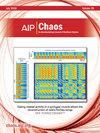Lorenz-84混沌吸引子的结构分析。
IF 3.2
2区 数学
Q1 MATHEMATICS, APPLIED
引用次数: 0
摘要
本文研究了Lorenz-84吸引子的结构。它的动力学属于弱耗散混沌,不能用经典方法来分析其结构。为此引入了颜色示踪映射,用于提取吸引子的三维结构。分析表明,吸引子是非平凡的环面混沌情况:它是围绕一个周期为2的空腔组织的。此外,该结构揭示了吸引子产生混沌的新机制:多向拉伸。然后将吸引子结构人工地表示在二维分支流形上,并使用先前提取的一组周期轨道进行验证。本文章由计算机程序翻译,如有差异,请以英文原文为准。
Structure analysis of the Lorenz-84 chaotic attractor.
The structure of the Lorenz-84 attractor is investigated in this study. Its dynamics belonging to weakly dissipative chaos, classical approaches cannot be used to analyze its structure. The color tracer mapping is introduced for this purpose and used to extract the three-dimensional structure of the attractor. The analysis shows that the attractor is a nontrivial case of toroidal chaos: it is organized around a period-2 cavity. Moreover, the structure reveals a new mechanism generating chaos in the attractor: a multidirectional stretching. The attractor structure is then artificially represented on a two-dimensional branched manifold, and its validation is performed using a set of periodic orbits previously extracted.
求助全文
通过发布文献求助,成功后即可免费获取论文全文。
去求助
来源期刊

Chaos
物理-物理:数学物理
CiteScore
5.20
自引率
13.80%
发文量
448
审稿时长
2.3 months
期刊介绍:
Chaos: An Interdisciplinary Journal of Nonlinear Science is a peer-reviewed journal devoted to increasing the understanding of nonlinear phenomena and describing the manifestations in a manner comprehensible to researchers from a broad spectrum of disciplines.
 求助内容:
求助内容: 应助结果提醒方式:
应助结果提醒方式:


